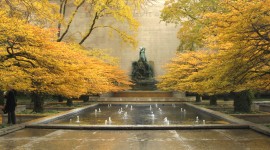Landscape Information
A monumental civic space fronting Lake Michigan, this 319-acre park is sited on public land founded in 1835 and infill created from the detritus of the Great Chicago Fire of 1871. Known from 1847 as Lake Park, it was renamed in honor of Ulysses S. Grant in 1901. The park’s formal, parterre landscape was designed by Edward H. Bennett around the same time.
Daniel H. Burnham and Bennett’s Plan of Chicago (1909) visualized the park as a French-Renaissance landscape featuring civic institutions, a vision hampered by longstanding regulations protecting the park as open space. This situation was resolved when the southern part of the park expanded through numerous infill projects, most notably under landscape architect Alfred Caldwell utilizing Works Progress Administration (WPA) funds in the 1930s.
Significant as the site of numerous demonstrations in 1968 during the Democratic National Convention, the park is home to the Field Museum of Natural History, Art Institute of Chicago, and Shedd Aquarium, with Adler Planetarium nearby in Burnham Park. In 1995 the space between these civic structures, known as Museum Campus, was transformed from an expanse of pavement to broad sweeps of lawn with paths and trees. Twenty years later Maggie Daley Park, designed by Michael Van Valkenburgh Associates landscape architects, was established to the immediate north of the park.
Additional features of Grant Park include the General John Alexander Logan Monument (1897), designed by architect Stanford White, and sculptors Augustus Saint-Gaudens and Alexander Phimister Proctor; and the Clarence Buckingham Memorial Fountain (1927). The Beaux-Arts water feature was given by Kate Buckingham in honor of her brother and was designed by architects Bennett, Parsons & Frost, working with engineer Jacques H. Lambert and sculptor Marcel Francois Loyau.
Grant Park is a contributing feature of the Historic Resources of the Chicago Park District listed in the National Register of Historic Places in 1990. It was individually listed in 1993.



















